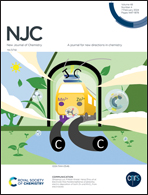Methylene blue loaded K0.3Bi0.7F2.4:Yb,Er upconversion nanoparticles for near-infrared activated photodynamic therapy†
Abstract
Bismuth-based fluoride nanoparticles have received a lot of interest as host materials for upconversion and have been recommended for lighting devices and biological applications. Bismuth is known to be an ecofriendly metal and as a result it is crucial to determine the true potential of bismuth-based nanoparticles for biological applications. However, even though these materials seem to be promising, K0.3Bi0.7F2.4:Yb,Er UCNPs are rarely explored for biological applications like photodynamic therapy (PDT). The ability of upconversion nanoparticles (UCNPs) to convert near-infrared (NIR) light into visible light makes them intriguing options for use in PDT. In this study we have succeeded in developing a new kind of UCNP (a rare earth-based host matrix/MB-based PDT drug, K0.3Bi0.7F2.4:Yb,Er@SiO2(MB)), with a particle diameter of less than 50 nm for NIR activated PDT. Upon excitation at 980 nm, emission from the UCNPs activates the photosensitizer methylene blue, resulting in the generation of reactive oxygen species. Our findings suggest that methylene blue-loaded UCNPs can be an intriguing framework for future NIR-triggered PDT in the treatment of cancer. We believe that such a PDT medication has the potential to become a theranostic nanomedicine for cancer treatment.



 Please wait while we load your content...
Please wait while we load your content...